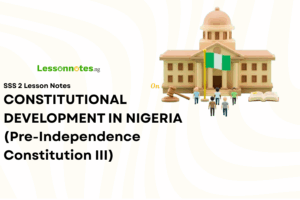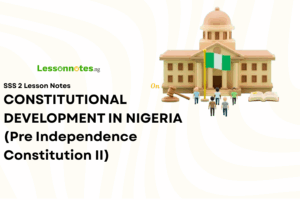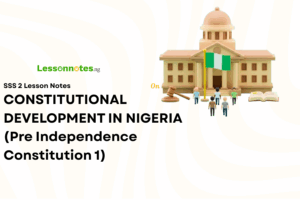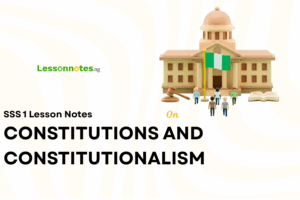Organization of Petroleum Exporting Countries (OPEC) SS3 Government Lesson Note
Download Lesson NoteTopic: Organization of Petroleum Exporting Countries (OPEC)
CONTENT
- Origin
- Aims and objectives
- Organs
ORIGIN OF OPEC
The Organization of Petroleum Exporting Countries (0PEC), composed of 13 third-world petroleum producing countries, was formed in 1960 to promote and protect the interests of its members. OPEC as an organisation was formed as a reaction to the exploitative motives of multinational companies, which at that time were controlling oil operations in the oil-producing countries in 1960. Five oil-producing countries met in Baghdad, the capital of Iraq to form a union that will fight against the exploitative tendencies of multinational companies.
The five countries that held the meeting were; Iran, Iraq, Kuwait, Saudi Arabia and Venezuela. Some other countries later joined the organisation because of its effort to curtail the activities of the oil companies. Countries like Algeria (1969), Nigeria (1971), Gabon and the United Arab Emirates (1973), joined the organisation.
AIMS AND OBJECTIVES
- OPEC was established to stabilise the price of oil in the World market
- To coordinate and unify: OPEC was formed to coordinate and harmonise oil policies of member nations to bring them in line with the standard set by OPEC.
- Steady Income: It was also formed to stabilise the oil income of its member states.
- To ensure a steady supply of oil to consuming nations.
- Quota: To fix and allocate production quotas to member nations.
- Protection of member states: It was formed to protect the interest of member states and also to ensure the participation of foreign multinational companies in oil exploitation does not threaten the interest of member nations.
- To negotiate for the participation of member nations in oil exploitation and exploration.
EVALUATION QUESTION
- Briefly describe the origin of OPEC.
- List five aims and objectives of OPEC.
ORGANS OF OPEC
- The conference
- The Board of Governors
- The Secretariat.
THE CONFERENCE
The Conference is the supreme organ of OPEC. Each member nation is represented by its Minister of Petroleum who leads the delegation to OPEC meetings. It meets twice a year but the Secretary-General can call for an extraordinary meeting after due consultation with the President of the Conference and approved by a simple majority of member-states. The ordinary meetings of the Conference are held in Vienna, Austria, the organisation’s headquarters and each member has a simple vote.
FUNCTIONS OF THE CONFERENCE
- The Conference formulates the general policy of the organisation and determines the appropriate methods and means of its implantation.
- It appoints the Secretary-General, the Deputy Secretary, the Chairman and the Alternate Chairman of the Board of Governors.
- It approves the appointment of the members of the Board of Governors.
- It considers the applications for membership in OPEC.
- It approves the budget of the Organization.
- The Conference considers and approves all reports and recommendations submitted by the Board of Governors.
- It appoints auditors that examine the accounts of the organisation.
THE BOARD OF GOVERNORS
This organ is made up of representatives called governors. Every governor has one vote and serves for a term of two years. The board meets at least twice a year.
FUNCTIONS OF THE BOARD OF GOVERNORS
- It manages the affairs of the organisation
- It prepares an agenda for the meeting of the conference.
- The board implements the decisions made by the conference.
- The board nominates the auditor of the organisation.
- The board also prepares the budget of the organisation.
- The board considers and submits the statement of account and the auditor’s report to the conference for approval.
- The board considers and takes decisions on any report submitted by the Secretary-General.
THE SECRETARIAT
The Secretariat of OPEC is located in its headquarters in Vienna, Austria. The organ carries out the executive functions of the organisation. The head of the secretariat is the Secretary-General, assisted by a deputy Secretary General and other members of staff. The Secretary-General has three years tenure and could be re-appointed.
FUNCTIONS OF THE SECRETARIAT
- The secretariat is responsible for all the correspondence of the organisation.
- It performs the executive and administrative functions of the organisation.
- It represents the organisation.
The departments of the secretariat are;
- Information department
- Economic department
- Administrative department.
- Technical department.
EVALUATION QUESTIONS
- List five functions of the conference of OPEC.
- List five functions of the board of governors of OPEC.
GENERAL EVALUATION/REVISION QUESTIONS
- Explain the causes of the Kaduna state executive/legislative crisis of 1981.
- Enumerate the immediate causes of the civil war.
- Enumerate the positive consequences of the civil war
READING ASSIGNMENT
- Essential Government by C.C. Dibie pages 264-265
- Comprehensive government by J.U. Anyaele pages 229-230
WEEKEND ASSIGNMENT
- OPEC was established in____ (a) 1962 (b) 1970 (c) 1960
- Nigeria was admitted into OPEC in the year____ (a) 1971 (b) 1970 (c) 1981
- The supreme organ of OPEC is _____ (a) The Secretariat (b) The Board of Governors (c) The Conference
- The annual budget of OPEC is prepared by the____ (a) Board of Governors (b) Conference (c) Secretariat
- The headquarters of OPEC is located in_____ (a) London (b) New York (c) Austria.
THEORY
- Highlight 4 functions of the Conference of OPEC.
- State 5 aims and objectives of OPEC





















